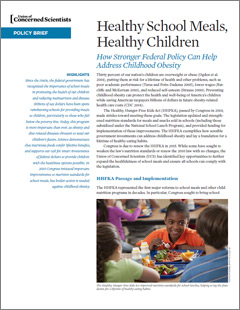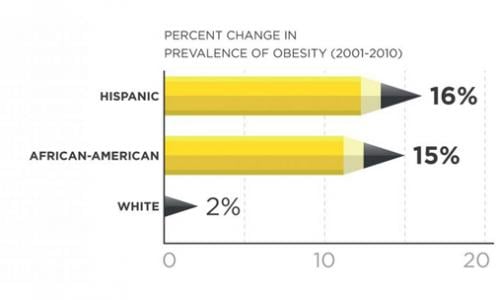Thirty percent of our nation’s children are overweight or obese, putting them at risk for a lifetime of health and other problems, such as poor academic performance, lower wages, and reduced self-esteem. Preventing childhood obesity can protect the health and well-being of US children while saving taxpayers billions of dollars in future obesity-related health care costs.
The Healthy, Hunger-Free Kids Act (HHFKA), passed by Congress in 2010, made strides toward meeting these goals. The legislation updated and strengthened nutrition standards for meals and snacks sold in schools (including those subsidized under the National School Lunch Program), and provided funding for implementation of these improvements. The HHFKA exemplifies how sensible government investments can address childhood obesity and lay a foundation for a lifetime of healthy eating habits.
Congress is due to renew the HHFKA in 2015. While some have sought to weaken the law’s nutrition standards or renew the 2010 law with no changes, the Union of Concerned Scientists (UCS) has identified key opportunities to further expand the healthfulness of school meals and ensure all schools can comply with the legislation.
HHFKA passage and implementation
The HHFKA represented the first major reforms to school meals and other child nutrition programs in decades. In particular, Congress sought to bring school meals and snacks into accord with federal dietary guidelines. Relying on recommendations from the Institute of Medicine and in consultation with a variety of stakeholders, the U.S. Department of Agriculture (USDA) issued regulations implementing the law that required schools to provide more fruits and vegetables, lower-fat milk options, less sodium and fat, fewer calories, and higher quantities of whole grains in school meals and snacks. School lunches meeting the new standards would be entitled to an additional reimbursement of six cents per meal served.
Since the HHFKA’s passage in 2010, some of the law’s biggest supporters—notably the School Nutrition Association (SNA)—have radically changed their position and now oppose many of the law’s key provisions. Their criticisms primarily focus on the challenges some schools have encountered in implementing the new provisions, with some reporting higher meal costs, lost revenue, increased waste, and dissatisfaction with the taste of healthier meals.
Independent analysis has disputed some of these claims and has found that students’ consumption of fruits and vegetables increased since the law took effect. The vast majority of schools have successfully met implementation targets. Struggling schools have been offered a variety of resources, including a USDA-established task force that provides technical support and partnerships with independent groups to improve the taste, presentation, and other aspects of school meals.
UCS and other proponents of the law have asserted the need to confront and resolve implementation challenges without materially weakening or abandoning the nutrition standards. We disagree with the SNA’s proposal to change the law to allow schools broad latitude to opt out of the new requirements. The childhood obesity crisis, with its implications for children’s future health and wellness, demands that we defend—and look for opportunities to expand on—recent victories.
UCS Recommendations
Immediate action is needed to improve children’s diets, avert long-term health consequences, and save billions of taxpayer dollars on preventable diet-related chronic diseases. While significant improvements to the nutrition standards of school meals were made in 2010, we urge Congress to build on these gains when it renews the HHFKA.
Specifically, we recommend that Congress:
Protect gains made in 2010. The vast majority of schools are in compliance with the new law, and support is available for those who are struggling. Retreating from our commitment to healthier school meals is not an option in the face of the childhood obesity crisis.
Increase federal meal reimbursement rate. Our commitment to healthier meals should be backed up with additional funding. Schools have encountered the same reality already known to most people—less-healthy processed foods are often cheaper than whole food ingredients like fresh fruits and vegetables and unprocessed meats. We recommend raising the reimbursement rate for meals in compliance with nutrition standards to allow schools more flexibility to buy the healthiest foods possible.
Improve nutrition education. We urge Congress to fund nutrition education programs that engage all school staff—from cafeteria workers to teachers— to help children understand the basics of food, nutrition, cooking, and healthful choices. Such efforts can improve children’s understanding and acceptance of healthier meals at school and elsewhere.
Finance school cafeteria kitchen equipment. Some of the difficulties encountered in implementing new standards are due to a lack of appropriate kitchen equipment. Decades of underinvestment in school kitchens have left many schools with little capacity beyond heating and serving prepared, processed meals. Cooking with whole foods requires food workers to have suitable kitchen equipment like refrigeration and large-scale slicers to prepare meals from fresh ingredients. Congress should expand the availability of grants and loans to help schools outfit and update their kitchens.
Prioritize fruits and vegetables. Fruits and vegetables are critically under-consumed by children. More can and should be done to reverse this trend.
- Congress can further encourage fruit and vegetable consumption at schools by offering funding and other incentives for schools to go beyond the minimum servings of fruits and vegetables required by HHFKA, and to offer these healthy foods as snacks between meals.
- Research initiatives can measure changes in fruit and vegetable consumption and track related health outcomes from the programs described above, to assess their efficacy.
Increase funding for the Farm to School grant program. This program supports educational initiatives related to food production and nutrition. Examples include establishing school gardens that allow students to obtain firsthand experience with growing food and providing support so schools can source meal ingredients from local farms. Such initiatives have been shown to increase fruit and vegetable consumption. Due to the Farm to School grant program’s overwhelming popularity and demonstrated success, we recommend increasing its funding.
Not allow politics to trump science. Medical and nutrition experts are the best sources for setting nutritional standards for school lunches. Congress should continue to look to these experts for guidance, and push back on any attempts by food industry lobbyists and others to roll back these standards.







